Fig. 2.
Reconstructed transmission chains. A maximum likelihood transmission chains in the 2017 chikungunya outbreak in Lazio; the vertical dimension represents the time of symptom onset of individual cases. Horizontal bars at the top of the graph denote distinct focal clusters and are colored by the location of the cluster (blue, Anzio; red, Rome; green, others). Below the bars, we reported the total cluster size (for sizes ≥ 5) and the corresponding label (for sizes ≥ 10: A1 and A2, occurring in Anzio, and R1, occurring in Rome). Clusters are ordered horizontally by the date of the corresponding index case. Shown on the left-hand side of the panel are cases with no secondary focal transmission and no identified infector (“isolated cases”), disaggregated by whether they were exported or locally transmitted cases and color-coded by location; the size of the points is proportional to the number of isolated cases occurring in a given day, location, and scale of transmission (the minimum size corresponds to a single isolated case). b. Distributions of the number of secondary cases transmitted focally by each case for different locations of infectors; points, crude estimates from the transmission chains; lines and shaded areas, mean and 95%CI from a negative binomial fit of the points

